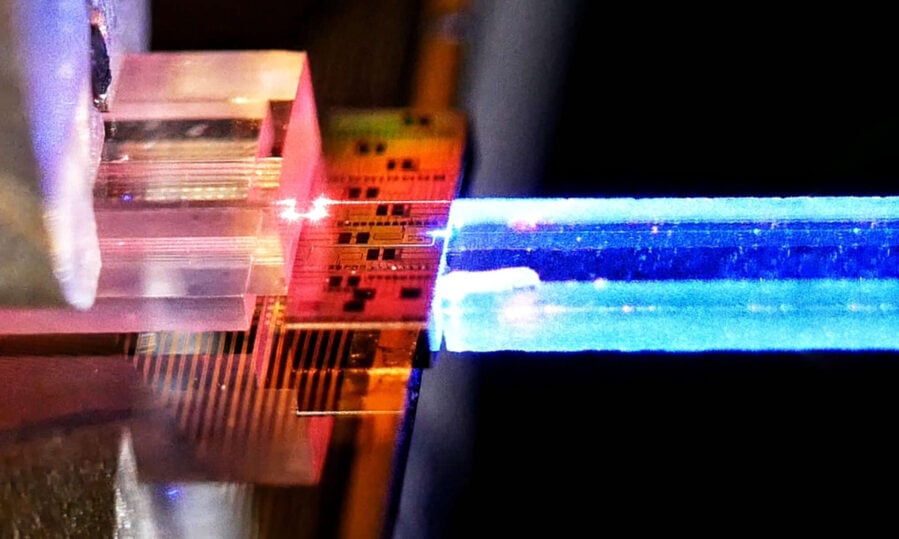Scientists have developed an innovative hybrid quantum photonics platform that could make quantum communication systems more practical and deployable, according to research published April 22, 2025, in Optica Quantum. The breakthrough combines traditional nonlinear crystals with advanced photonic integrated circuits to generate and manipulate special pairs of photons at widely different wavelengths.
Bridging Quantum Worlds with Light
The research team, led by scientists from Rochester Institute of Technology and the University of Rochester, demonstrated a unique approach to quantum networking by directly coupling a periodically poled potassium titanyl phosphate (PPKTP) crystal with silicon-based photonic integrated circuits (PICs). This innovation addresses a critical challenge in quantum networks: connecting quantum systems that operate at visible wavelengths with telecommunications infrastructure that works best with infrared light.
“The vibrations of a star are like its unique song,” said Yaguang Li, lead author of the study on stellar asteroseismology published in a separate paper. “By listening to those oscillations, we can precisely determine how massive a star is, how large it is, and how old it is.”
A similar principle applies to quantum states of light – they carry unique quantum information that can be precisely manipulated and measured, making them ideal for secure communications. This new platform generates pairs of entangled photons, with one at visible wavelengths (656 nm) and its partner at telecommunications wavelengths (1536 nm).
Practical Quantum Communications
What makes this approach significant is how it solves several practical challenges that have limited the deployment of quantum communication systems:
- Eliminates the need for expensive, bulky superconducting detectors by allowing the use of compact, room-temperature single-photon avalanche diodes (SPADs) for detection
- Provides built-in filtering of background noise without additional components
- Enables on-chip modulation and manipulation of quantum states
- Leverages existing telecommunications fiber infrastructure for long-distance transmission
“When we find life on another planet, we will want to know how old that life is,” said Dr. Daniel Huber in his asteroseismology work. “Listening to the sounds of its star will tell us the answer.”
Similarly, quantum networks must listen for and detect the most subtle signals – single photons – with extremely high precision to function properly.
Tested on Real-World Network
The researchers demonstrated their system’s capabilities by sending quantum signals across the Rochester Quantum Network (RoQNET), which connects the Rochester Institute of Technology and University of Rochester campuses using approximately 38 kilometers of optical fiber. Despite significant signal loss over this distance, the system successfully maintained quantum correlations, proving its potential for practical applications.
The team measured and characterized their system extensively, finding coupling efficiencies between the crystal and photonic chip of 2.37 ± 1.03 dB at visible wavelengths and 4.46 ± 1.32 dB at telecom wavelengths. They also demonstrated that silicon waveguides on the chip provided 92.5 ± 2.5 dB of pump suppression – better than traditional optical filters while introducing less signal loss.
Future Quantum Networks
This hybrid platform represents a significant step toward practical quantum networks that could connect various quantum systems – such as those based on trapped ions, quantum dots, or color centers in diamond – over existing fiber optic infrastructure. The technology could enable more secure communications, distributed quantum computing, and potentially quantum-enhanced sensing applications.
The research was funded by the Air Force Research Laboratory and represents collaboration between academic institutions and industry partners including AdvR Inc. and AIM Photonics. The investigators are now working on packaging the system components for increased stability and exploring new materials to expand the platform’s capabilities.
If our reporting has informed or inspired you, please consider making a donation. Every contribution, no matter the size, empowers us to continue delivering accurate, engaging, and trustworthy science and medical news. Independent journalism requires time, effort, and resources—your support ensures we can keep uncovering the stories that matter most to you.
Join us in making knowledge accessible and impactful. Thank you for standing with us!

